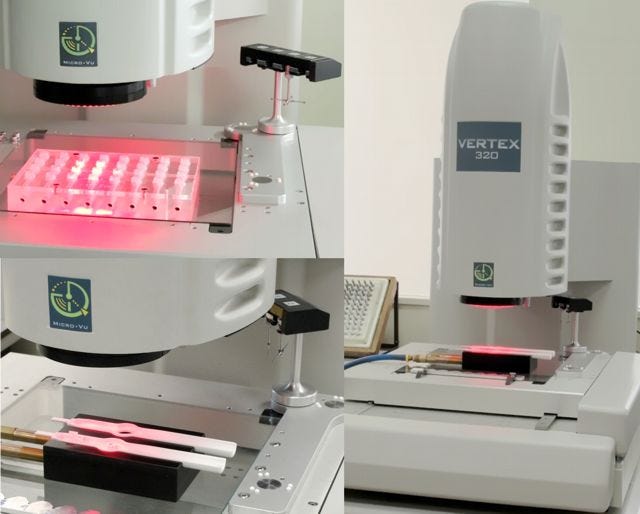September 16, 2015
For decades, many engineers have measured the accuracy of manufactured parts using a method bearing a certain resemblance to the method kids use to make shadow puppets appear on a wall.
Brian Buntz
|
The Micro-Vu Vertex vision system with a four-station touch probe kit is shown here testing a medical device component. |
For a substantial part of the twentieth century, the way the tolerances of manufactured objects was measured remained essentially unchanged. Invented in 1920, the optical comparator used for this purpose are similar to a complex overhead projector, which project a magnified image onto a screen--whether it be a projector slide or a mischievous student twisting his hands into the shape of a dog's head in front of the light when the teacher isn't looking.
In the case of an optical comparator, a part is put on a lit stage, which magnifies and projects a silhouette of it onto a screen using a series of lenses and mirrors. A screen overlay can help show how much the part being tested falls inside or outside of the shadow of the engineer's specs.
A central problem with the optical-comparator method is its less-than-stellar repeatability. "If you give three guys an assignment to measure a part with optical comparators, you might get three different answers," says Greg Chatfield, sales and support manager at Micro-Vu Corp. (Windsor, CA).
"One of the big changes we see in the medical device industry is that they are starting to retire their aging manual optical comparators," Chatfield says. "The optical comparators are not as accurate or reliable as some of the newer technologies out there, which also offer better repeatability."
The introduction of video overlays is another reason that a growing number of medical device companies, as well as electronics and plastic suppliers serving the medtech industry are turning to vision machines instead of optical comparators. Video overlays can essentially do what an optical comparator did with an optical-comparator overlay did, but can provide more data about how well the part meets prescribed tolerances. "You can get discrete data that gives real answers. You can know that one side of a part is, say, 15 microns too big," Chatfield says. "You can also get information on variables such as the max- and mid-point."
Two of the biggest medtech niches driving the uptick in precision measurement systems are the orthopedics and dental-implant industries. "In the orthopedics industry, when you are dealing with bone plates, bone screws, and stuff like that, a lot of it is based on profile tolerances--making sure something fits in an envelope," Chatfield says. "That kind of accuracy is also important for dental implants."
Chatfield also notices a growing interesting from medical device companies in automated metrology systems. "Many companies are finding that the automated systems help them stay competitive with offshore production from a cost perspective. Once you have an automated system up and running, the difference in operation costs in the United States versus someplace else is just a matter of electricity. And then you don't have to pay as much overhead for shipping," he says. "I tell our customers in the U.S. for the difference in cost between an automated and manual, the automated is well worth it. I encourage them to buy automated because it helps keep production in the US and it is just a matter of electricity here versus somewhere else. And you don't have to pay the overhead of shipping."
Micro-Vu practices what it preaches, using automated technology extensively in the production of its machines. "We automate our manufacturing quite a bit so that we can keep our production costs lower. We have some FMS flexible manufacturing systems in house. Our machines keep working and running parts to build our systems all day and night. As a result, we can compete with Chinese companies in terms of cost," Chatfield says. And the company also sells many of its systems in China. Asia is the company's biggest geographical market. "We are fully international. Less than half of our business in the United States."
Learn more about cutting-edge medical devices at MD&M Philadelphia, October 7-8. |
Brian Buntz is the editor-in-chief of Qmed. Follow him on Twitter at @brian_buntz.
Like what you're reading? Subscribe to our daily e-newsletter.
About the Author(s)
You May Also Like



